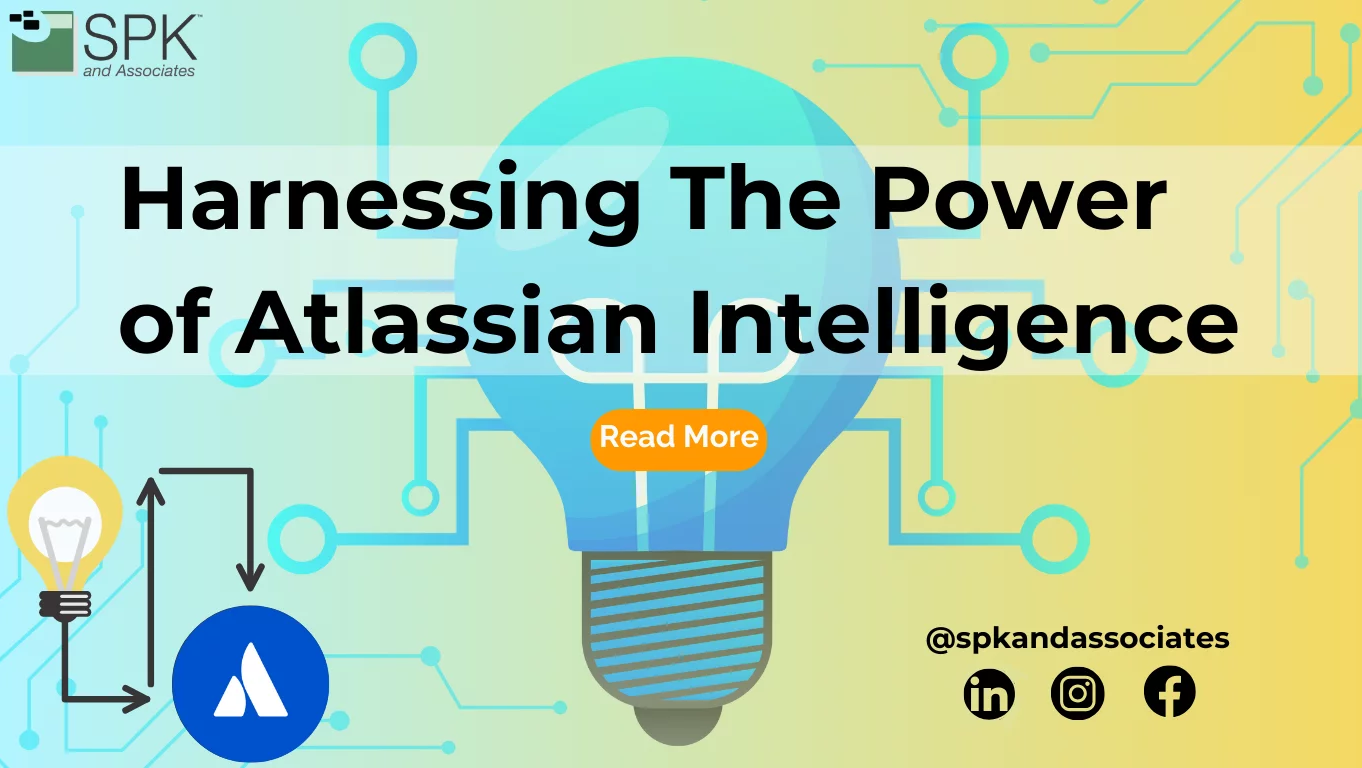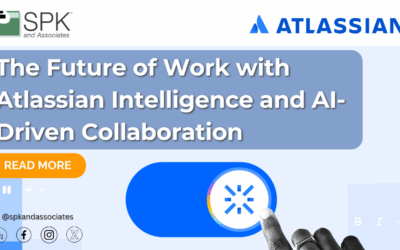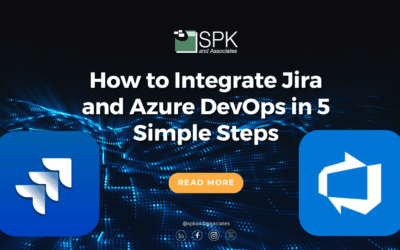Artificial intelligence (AI) is driving a seismic transformation that’s changing the way we work. According to McKinsey, artificial intelligence is used by 56% of companies worldwide. And, that number should keep growing. So what happens when you combine AI with a world-leading, team-centric products and solutions provider? Today, Atlassian’s tools aid 250,000+ customers to address diverse challenges, spanning space missions, climate change, code issues, and equipment requests.
Now, Atlassian users can utilize Atlassian Intelligence, an integrated virtual teammate across their cloud products, enhancing organizational efficiency.
What can you do with Atlassian Intelligence?
In December 2023, Atlassian launched general availability (GA) of Atlassian Intelligence.
Atlassian Intelligence, powered by artificial intelligence, is seamlessly integrated across various cloud products, including:
- Confluence.
- Bitbucket.
- Jira Software.
- Jira Service Management.
- Trello.
- Atlas.
- Atlassian Analytics.
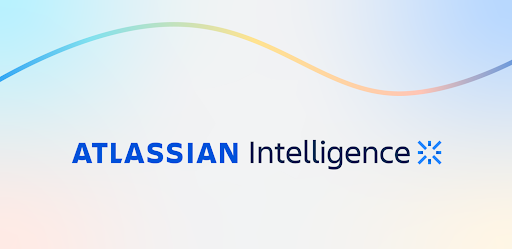
Atlassian Intelligence enhances team productivity by boosting individual output. Essentially, it taps into organizational data, making insights readily accessible. Thus, leveraging these insights streamlines data-driven decisions, enhancing overall team productivity.
For example:
- In Confluence: Your team can use Atlassian Intelligence to generate new content, edit the tone of their writing, summarize the main points, or ask where to find information.
- In Jira Software: You can summarize issue details, and in Jira Service Management, you can summarize issue details and suggest request types. ·
- You can generate SQL queries in Analytics, or search, summarize and transform content from Trello to Jira.
Now, let’s explore how Atlassian Intelligence’s evolving features will unlock productivity for your organization.
Accelerate Individual Productivity with Atlassian Intelligence
Firstly, with Atlassian Intelligence, team members can draft pages of business-critical content in seconds. Additionally, they can automate routine tasks by simply asking in plain natural language. And, they can even summarize long-winded content instantly. Atlassian Intelligence leverages the unique information in Jira and Confluence. Consequently, the help is always relevant to each organization and individual. That means everyone can do their best work — with speed, efficiency, and excellence.
Atlassian Intelligence Features For Productivity
- Generative AI in Editor: Instantly create user stories within Jira Software tickets, change the tone on a customer response within Jira Service Management from factual to empathetic, or generate a starting point for a test plan in Confluence.
- AI powered summaries: Get up to speed on any topic or project faster with AI generated summaries of Confluence pages AND quickly resolve incidents with issue summaries in Jira Service Management.
- Natural Language Automation: Eliminate busywork by automating any action quickly using natural language in Confluence. Coming soon to Jira Software.
- AI definitions BETA: Demystify company specific concepts, jargon, or acronyms on the spot with Atlassian Intelligence in Confluence. Coming soon to Jira Software and Jira Service Management.
“In my day-to-day work, Atlassian Intelligence acts as a virtual teammate that summarizes 5-page PIR reports into 5-sentence recaps for me, so I can get up to speed quickly ahead of monthly review meetings,” said Group Chief Technology Officer Matthias Hansen, “It’s already proven its worth by improving productivity across our product teams, with one manager sharing that he saved over 2 hours within the first week he used it.”
Gleaning Insights from Organizational Data
Next, Atlassian Intelligence enables teams to gather actionable insights from data – faster than ever before. For example, teams can effortlessly construct complex JQL and SQL queries in Jira and Atlassian Analytics using natural language. Ultimately, this facilitates instant data-driven decisions.Furthermore, the open-by-default nature of Atlassian’s products lets you leverage data from beyond Atlassian’s toolset. That means you can access richer insights while maintaining enterprise-grade permissions and security.
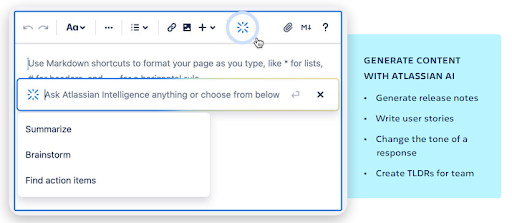
Atlassian Intelligence Features For Data Insights
- Natural Language to JQL: Use natural language to easily and quickly find issues and their dependencies, even those requiring complex JQL queries in Jira Software or Jira Work Management.
- Natural Language to SQL: Expand access to robust insights in Atlassian Analytics beyond data science teams so every team member can ask questions and get insights into key business metrics like project execution trends, customer support velocity, or team health.
- Q&A search in ConfluenceBETA: Go beyond basic search results. Obtain actionable information by querying project statuses, key workflows, or crucial organizational knowledge, including HR policies. Now in beta in Confluence.
- Q&A search in CompassBETA: Interrogate your tech stack in plain language for precise answers on components and deployments, minimizing time spent searching across diverse tools and microservices.
Useful AI Terminology
Next we will explore more about the Artificial Intelligence used in Atlassian Intelligence. But, before we do, here is a quick glossary for some of the terminology.
- Artificial Intelligence (AI): A field of computer science focused on creating systems to perform tasks that normally require human intelligence
- Machine Learning (ML): A subset of AI that involves AI algorithms that improve their performance through experience or data (i.e. “learn”)
- Generative AI: A type of AI (and ML) system that creates new content, such as images, text, or music, based on patterns learned from existing data (ex. web data)
- Large Language Model (LLM): A type of generative AI focused on text as an input and output ·
- ChatGPT: Example of an LLM created by OpenAI
- JQL: Jira Query Language – an example of a complex programming language that ChatGPT and other LLMs are able to write.
How Does Atlassian Intelligence Work?
Leveraging over 20 years of data on software, IT, and business teams, Atlassian Intelligence uniquely comprehends teamwork dynamics. It offers a virtual teammate, deeply understanding and accelerating collaboration. Atlassian Intelligence, developed with OpenAI, is integrated into the Atlassian platform, a unified technology base across all cloud products.
Moreover, Atlassian Intelligence uses the teamwork graph, which is unique to your teams’ project or service work, to deliver results specific to your organization’s context.And, the knowledge underpinning the teamwork graph is modeled on the two most common types of teamwork:
- Service-based work: teams accepting incoming requests for help and using custom workflows and data to drive resolutions for employees and customers.
- Project-based work: teams managing projects from concept to delivery with roadmaps, plans, tasks, goals, and documentation.
Using large language models, Atlassian Intelligence determines how teams at a given company work together, Then it constructs a custom teamwork graph showing the types of work being done and the relationship between them. Plus, with the open approach of the Atlassian platform, the teamwork graph is also enriched with additional context and data from the third-party apps teams use.
Atlassian’s Responsible Technology Principles
Atlassian’s mission is to unleash the potential of every team. And, Atlassian’s software products are meant to do just that: Fast-track collaboration and empower teams of all sizes, industries, and expertise. Technologies (and the data that powers them) are a reflection of our societies, values and behaviors. Collectively, technology and its many participants are at a critical moment for new technologies like artificial intelligence (AI). So, to uphold its own mission and values, Atlassian has created a set of principles to guide its work in building new technologies like artificial intelligence. In sharing these principles with you, we invite you to use, collaborate and offer feedback on the same open source Responsible Technology framework it uses. You can share the Responsible Technology Review Template with your team, and review the full principles.
Below is also a quick overview for ease of reference:
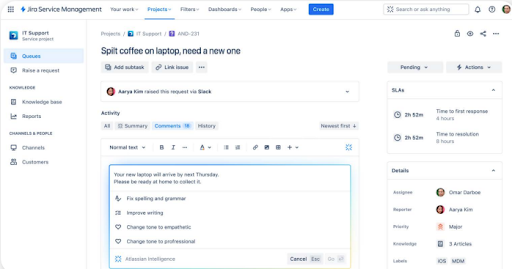
Open communication, no bullsh*t
Openness is foundational to Atlassian — one of our core values is Open Company, No Bullsh*t. It’s important that anyone who wants to make the most of new technologies is equipped with the right information to do so.
Build for Trust
Trust is at the heart of our work and our products: if someone doesn’t trust our company, they won’t use our products or want to work here. This extends to the technologies that underpin and power our products and our work.
Accountability is a team sport
At Atlassian, we know a thing or two about collaboration and teamwork. Our products are powered by our own people, upon the foundational technologies that we use to deliver them — and, of course, by how our customers’ teams choose to use them.
Empower all humans
At Atlassian, we want our company and our technologies to be open, inclusive, fair and just: to reflect the human-centric values and fundamental human rights that we all share. Our journey to build responsibly reflects this aim.
Unleash potential (not inequity)
We know that behind every great human achievement, there is a team. We also believe that new technologies can help empower those teams to achieve even more. If we use these technologies (like AI) responsibly and intentionally, then we can supercharge this vision and contribute to better outcomes across our communities.
What’s Next for Atlassian Intelligence?
As your organization grows, so does the institutional knowledge and terms used to describe projects, acronyms, and internal systems. Building a shared understanding of what all these things mean and who knows about them is incredibly hard. That’s why Atlassian Intelligence provides shared context with an on-demand dictionary specific to your company, your teams, and their work. For example, you can highlight a term and ask Atlassian Intelligence to explain it with the definition, source of information, internal subject matter experts. Or, even how it connects to related work based on the teamwork graph.
Contact the SPK team today to learn more about Atlassian Intelligence and how you can take advantage of it.


